Chapter: Distributed Systems : Process & Resource Management
CORBA IDL
CORBA IDL
These are
preceded by definitions of two structs,
which are used as parameter types in defining the methods. Note in particular
that GraphicalObject is defined as a struct , whereas it was a class in the
Java RMI example. A component whose type is a struct has a set of fields containing values of various types like
the instance variables of an object, but it has no methods.
Parameters and results in CORBA IDL:
Each
parameter is marked as being for input or output or both, using the keywords in , out
or inout illustrates a simple example
of the use of those keywords
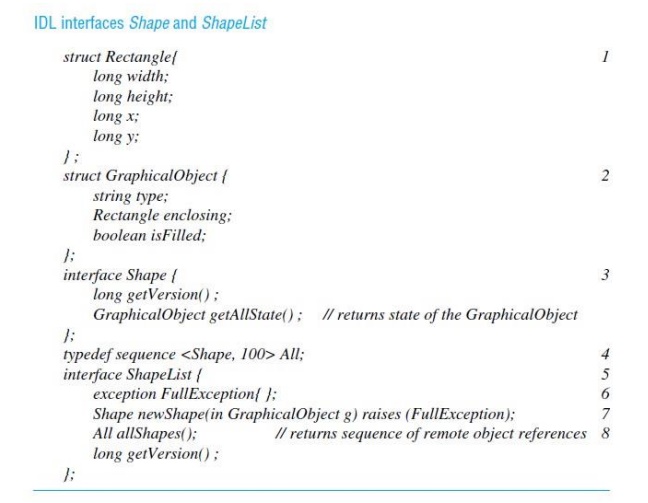
The
semantics of parameter passing are as follows:
Passing CORBA objects:
Any
parameter whose type is specified by the name of an IDL interface, such as the return
value
Shape in line 7, is a reference to a
CORBA object and the value of a remote object reference is passed.
Passing CORBA primitive and constructed types:
Arguments
of primitive and constructed types are copied and passed by value. On arrival, a
new value is created in the recipient’s process. For example, the struct GraphicalObject passed as
argument (in line 7) produces a new copy of this struct at the server.
Type Object :
Object is the name of a type whose
values are remote object references. It is effectively a common supertype of all of IDL interface types such as Shape and ShapeList.
Exceptions in CORBA IDL:
CORBA IDL
allows exceptions to be defined in interfaces and thrown by their methods. To
illustrate this point, we have defined our list of shapes in the server as a
sequence of a fixed length (line 4) and have defined FullException (line 6), which is thrown by the method newShape (line 7) if the client attempts
to add a shape when the sequence is full.
Invocation semantics:
Remote
invocation in CORBA has at-most-once
call semantics as the default. However, IDL may specify that the invocation of
a particular method has maybe
semantics by using the oneway
keyword. The client does not block on oneway
requests, which can be used only for methods without results.
The CORBA Naming service
It is a
binder that provides operations including rebind
for servers to register the remote object references of CORBA objects by name
and resolve for clients to look them
up by name. The names are structured in a hierarchic fashion, and each name in
a path is inside a structure called a
NameComponent . This makes access in a simple
example seem rather complex.
CORBA pseudo objects
Implementations
of CORBA provide interfaces to the functionality of the ORB that programmers
need to use. In particular, they include interfaces to two of the components in
the ORB core and the Object Adaptor
CORBA client and server example
This is
followed by a discussion of callbacks in CORBA. We use Java as the client and
server languages, but the approach is similar for other languages. The
interface compiler idlj can be
applied to the CORBA interfaces to generate the following items:
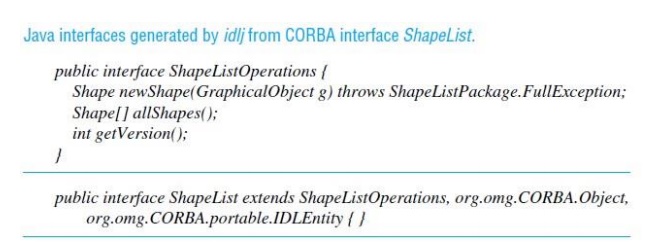
The
equivalent Java interfaces – two per IDL interface. The name of the first Java
interface ends in Operations – this
interface just defines the operations in the IDL interface. The Java second
interface has the same name as the IDL interface and implements the operations
in the first interface as well as those in an interface suitable for a CORBA
object.
The
server skeletons for each idl
interface. The names of skeleton classes end in POA , for example ShapeListPOA.
The proxy
classes or client stubs, one for each IDL interface. The names of these classes
end in Stub , for example _ShapeListStub\
A Java
class to correspond to each of the structs
defined with the IDL interfaces. In our example, classes Rectangle and GraphicalObject
are generated. Each of these classes contains a declaration of one instance variable
for each field in the corresponding struct
and a pair of constructors, but no other methods.
Classes
called helpers and holders, one for each of the types defined in the IDL
interface. A helper class contains the narrow
method, which is used to cast down from a given object reference to the class
to which it belongs, which is lower down the class hierarchy. For example, the narrow method in ShapeHelper casts down to class Shape
. The holder classes deal with out
and inout arguments, which cannot be
mapped directly onto Java.
Server program
The
server program should contain implementations of one or more IDL interfaces.
For a server written in an object-oriented language such as Java or C++, these
implementations are implemented as servant classes. CORBA objects are instances
of servant classes.
When a
server creates an instance of a servant class, it must register it with the
POA, which makes the instance into a CORBA object and gives it a remote object
reference. Unless this is done, the CORBA object will not be able to receive
remote invocations. Readers who studied Chapter 5 carefully may realize that
registering the object with the POA causes it to be recorded in the CORBA
equivalent of the remote object table.
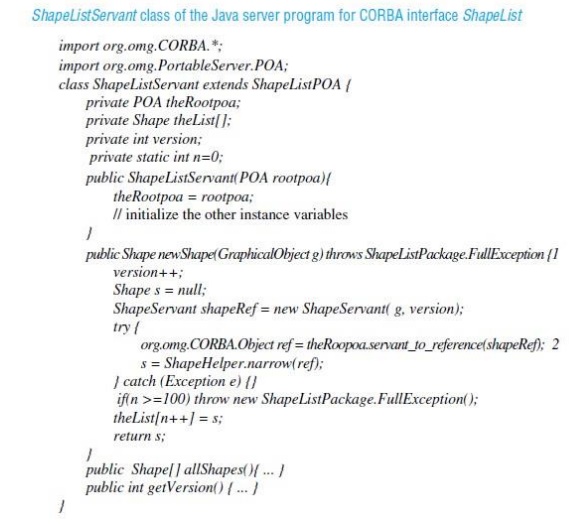
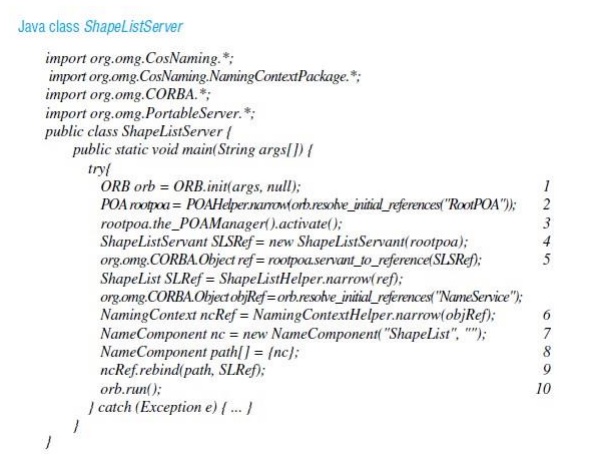
The client program
It
creates and initializes an ORB (line 1), then contacts the Naming Service to
get a reference to the remote ShapeList
object by using its resolve method
(line 2). After that it invokes its method allShapes
(line 3) to obtain a sequence of remote object references to all the Shapes currently held at the server. It then invokes the getAllState method (line 4), giving as argument the first remote
object reference in the sequence returned; the result is supplied as an instance
of the
GraphicalObject class.
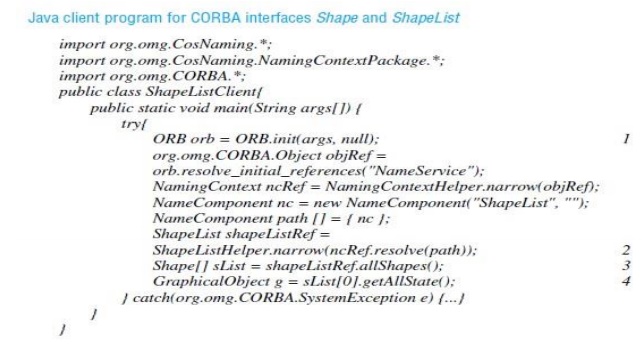
Callbacks
Callbacks
can be implemented in CORBA in a manner similar to the one described for Java
RMI For example, the WhiteboardCallback
interface may be defined as follows:
interface WhiteboardCallback { oneway void
callback(in int version); };
This
interface is implemented as a CORBA object by the client, enabling the server
to send the client a version number whenever new objects are added. But before
the server can do this, the client needs to inform the server of the remote
object reference of its object. To make this possible, the ShapeList interface requires additional methods such as register and deregister, as follows:
int register(in WhiteboardCallback callback); void
deregister(in int callbackId);
After a client
has obtained a reference to
the ShapeList object and created an instance
of
WhiteboardCallback, it uses
the register method of ShapeList to inform the server that it
is interested in receiving callbacks.
The ShapeList object in the server is
responsible for keeping a list of interested clients and notifying all of them
each time its version number increases when a new object is added.
The architecture of CORBA
The
architecture is designed to support the role of an object request broker that
enables clients to invoke methods in remote objects, where both clients and
servers can be implemented in a variety of programming languages. The main
components of the CORBA architecture are illustrated in Figure
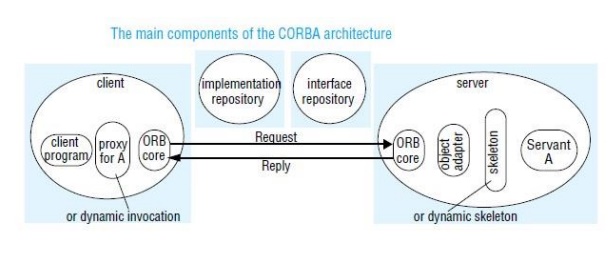
CORBA
provides for both static and dynamic invocations. Static invocations are used
when the remote interface of the CORBA object is known at compile time,
enabling client stubs and server skeletons to be used. If the remote interface
is not known at compile time, dynamic invocation must be used. Most programmers
prefer to use static invocation because it provides a more natural programming
model.
ORB core
◊ The role of the ORB core is similar to that of the communication module . In
addition, an ORB core provides an interface that includes the following:
operations
enabling it to be started and stopped;
operations
to convert between remote object references and strings;
operations
to provide argument lists for requests using dynamic invocation.
Object adapter
The role
of an object adapter is to bridge the
gap between CORBA objects with IDL interfaces and the programming language
interfaces of the corresponding servant classes. This role also includes that
of the remote reference and dispatcher modules. An object adapter has the
following tasks:
it
creates remote object references for CORBA objects;
it
dispatches each RMI via a skeleton to the appropriate servant;
it
activates and deactivates servants.
An object
adapter gives each CORBA object a unique object
name, which forms part of its remote object reference. The same name is
used each time an object is activated. The object name may be specified by the
application program or generated by the object adapter. Each CORBA object is
registered with its object adapter, which may keep a remote object table that
maps the names of CORBA objects to their servants.
Portable object adapter
The CORBA
2.2 standard for object adapters is called the Portable Object Adapter. It is
called portable because it allows applications and servants to be run on ORBs
produced by different developers [Vinoski 1998]. This is achieved by means of
the standardization of the skeleton classes and of the interactions between the
POA and the servants. The POA supports CORBA objects with two different sorts
of lifetimes:
those
whose lifetimes are restricted to that of the process their servants are
instantiated in;
those whose
lifetimes can span the instantiations of servants in multiple processes.
Skeletons
Skeleton
classes are generated in the language of the server by an IDL compiler. As
before, remote method invocations are dispatched via the appropriate skeleton
to a particular servant, and the skeleton unmarshals the arguments in request
messages and marshals exceptions and results in reply messages.
Client stubs/proxies
These are
in the client language. The class of a proxy (for object oriented languages) or
a set of stub procedures (for procedural languages) is generated from an IDL
interface by an IDL compiler for the client language. As before, the client
stubs/proxies marshal the arguments in invocation requests and unmarshal
exceptions and results in replies.
Implementation repository
An
implementation repository is responsible for activating registered servers on
demand and for locating servers that are currently running. The object adapter
name is used to refer to servers when registering and activating them.
An
implementation repository stores a mapping from the names of object adapters to
the pathnames of files containing object implementations.
Object
implementations and object adapter names are generally registered with the
implementation repository when server programs are installed.
When
object implementations are activated in servers, the hostname and port number
of the server are added to the mapping.
Interface repository
The role
of the interface repository is to provide information about registered IDL
interfaces to clients and servers that require it. For an interface of a given
type it can supply the names of the methods and for each method, the names and
types of the arguments and exceptions. Thus, the interface repository adds a
facility for reflection to CORBA
Dynamic invocation interface
The
dynamic invocation interface allows clients to make dynamic invocations on
remote CORBA objects. It is used when it is not practical to employ proxies.
The client can obtain from the interface repository the necessary information
about the methods available for a given CORBA object. The client may use this
information to construct an invocation with suitable arguments and send it to
the server.
Dynamic skeletons
If a
server uses dynamic skeletons, then it can accept invocations on the interface
of a CORBA object for which it has no skeleton. When a dynamic skeleton
receives an invocation, it inspects the contents of the request to discover its
target object, the method to be invoked and the arguments. It then invokes the
target.
Legacy code
The term legacy code refers to existing code that
was not designed with distributed objects in mind. A piece of legacy code may
be made into a CORBA object by defining an IDL interface for it and providing
an implementation of an appropriate object adapter and the necessary skeletons.
CORBA Interface Definition Language
The CORBA
Interface Definition Language, IDL, provides facilities for defining modules,
interfaces, types, attributes and method signatures. IDL has the same lexical
rules as C++ but has additional keywords to support distribution, for example interface, any, attribute, in, out,
inout, readonly, raises. It also
allows standard C++ preprocessing facilities.
IDL Modules
The
module construct allows interfaces and other IDL type definitions to be grouped
in logical units. A module defines a
naming scope, which prevents names defined within a module clashing with names
defined outside it.
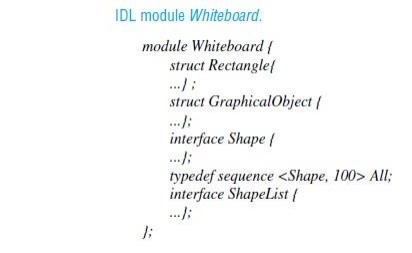
IDL interface
An IDL
interface describes the methods that are available in CORBA objects that
implement that interface. Clients of a CORBA object may be developed just from
the knowledge of its IDL interface.
IDL methods
The
general form of a method signature is:
[oneway]
<return_type> <method_name> (parameter1,..., parameterL) [raises
(except1,..., exceptN)] [context (name1,..., nameM)]
where the
expressions in square brackets are optional. For an example of a method signature
that contains only the required parts, consider:
void
getPerson(in string name, out Person p);
IDL types
IDL
supports fifteen primitive types, which include short (16-bit), long (32- bit),
unsigned short, unsigned long, float (32-bit), double (64-bit), char, Boolean
(TRUE, FALSE), octet (8-bit), and any (which can represent any primitive or
constructed type).
Attributes
IDL
interfaces can have attributes as well as methods. Attributes are like public
class fields in Java. Attributes may be defined as readonly where appropriate. The attributes are private to CORBA
objects, but for each attribute declared, a pair of accessor methods is
generated automatically by the IDL compiler, one to retrieve the value of the
attribute and the other to set it. For readonly
attributes, only the getter method is provided. For example, the PersonList interface defined in Figure
5.2 includes the following definition of an attribute: readonly attribute string
listname;
Inheritance
IDL
interfaces may be extended. For example, if interface B extends interface A,
this means that it may add new types, constants, exceptions, methods and
attributes to those of A. An extended
interface can redefine types, constants and exceptions, but is not allowed to
redefine methods. A value of an extended type is valid as the value of a
parameter or result of the parent type. For example, the type B is valid as the value of a parameter
or result of the type A.
interface A { };
interface B: A{ };
interface C {};
interface Z : B, C {};

Related Topics